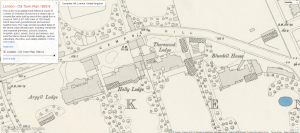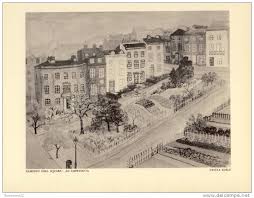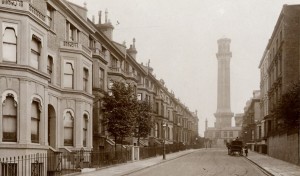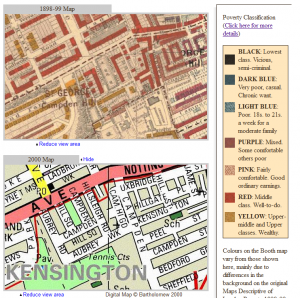In Amy Levy’s Romance of a Shop, New Street is briefly mentioned by Phyllis as she, Conny, and Gertrude travel to their new home on Upper Baker Street. “‘What number did you say, Gertrude?’ asked Phyllis, as the carriage turned into New Street, from Gloucester Place” (Levy 75). It’s purpose is minimal, serving as a transitional landmark as the sisters approach their new home on Upper Baker Street. In the footnotes of the text, it is even mentioned, “…. New Street runs eastward into Upper Baker Street” (Levy 75).
Here is a view of it on the Victorian map:
And here is a map of it on the Charles Booth Online Archive:
Now in comparison to Campden Hill, which was filled with red and yellow indicating that it was a pretty well off area. In comparison, the areas all around New Street are a mixture of light and dark blues, indicating a poorer status. In addition to being a transitional setting from Campden Hill to Upper Baker Street, New Street also serves as a transition in surroundings. The Lorimer sisters used to live in an area very well off, and now are traveling into London, passing on this street, which seems to be of the poorer population.
It was hard to locate crimes on Old Bailey as it wasn’t specifically taking New Street, but all the streets in London into account. However I seem to have found some results and the most crimes committed on New Street include burglary, royal offences, and grand larceny (Old Bailey).
Works Cited:
Amy Levy. Romance of a Shop. N.p., 1888. Print.
“Map of New Street.” Charles Booth Online Archive. N.p., n.d. Web. 16 Dec. 2015. http://booth.lse.ac.uk/cgi-bin/do.pl?sub=view_booth_and_barth&args=533267,181456,1,large,0
“The Proceedings of the Old Bailey.” London History. N.p., n.d. Web. 16 Dec. 2015. <http://www.oldbaileyonline.org/static/London-life19th.jsp>.







